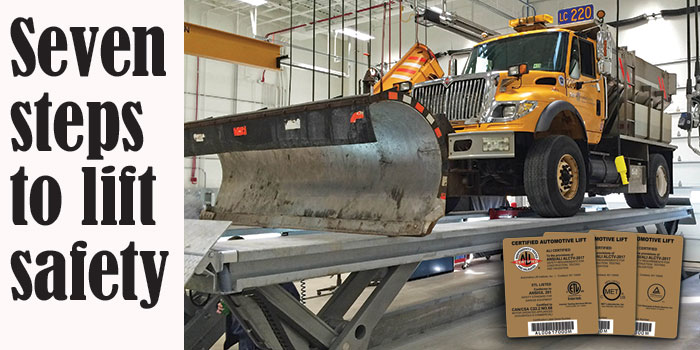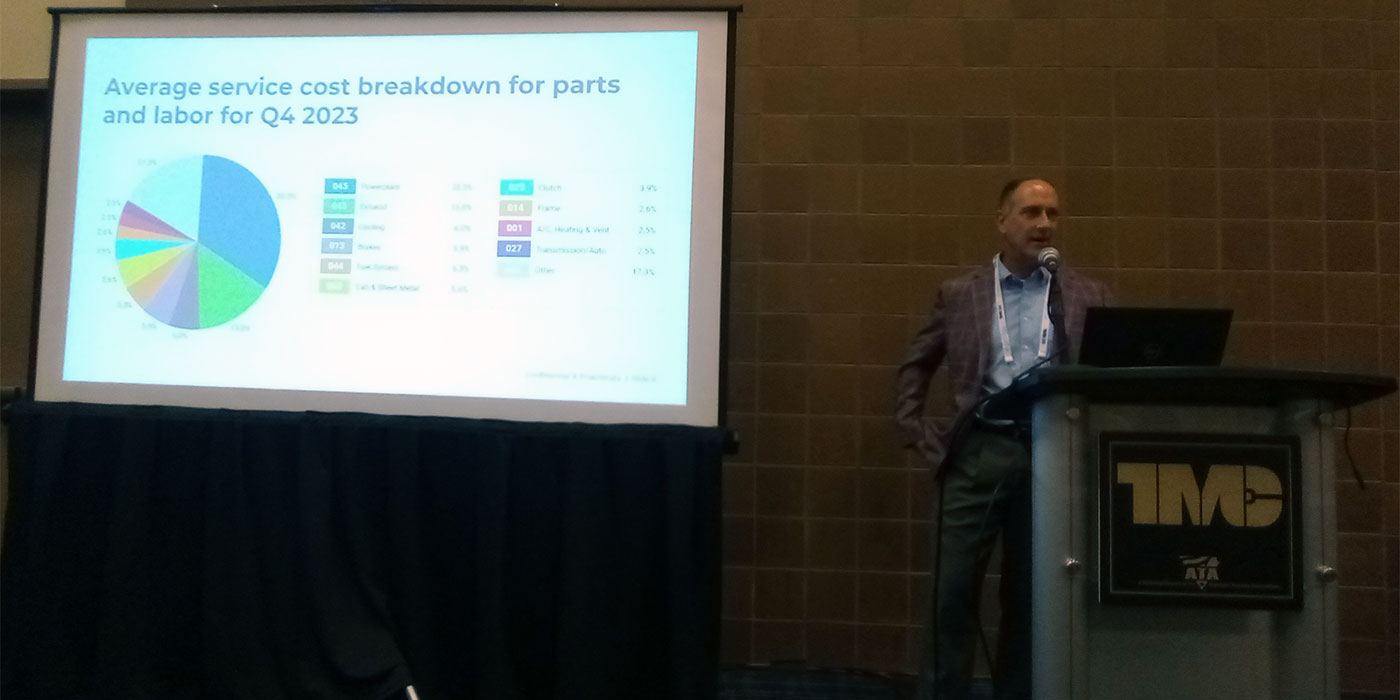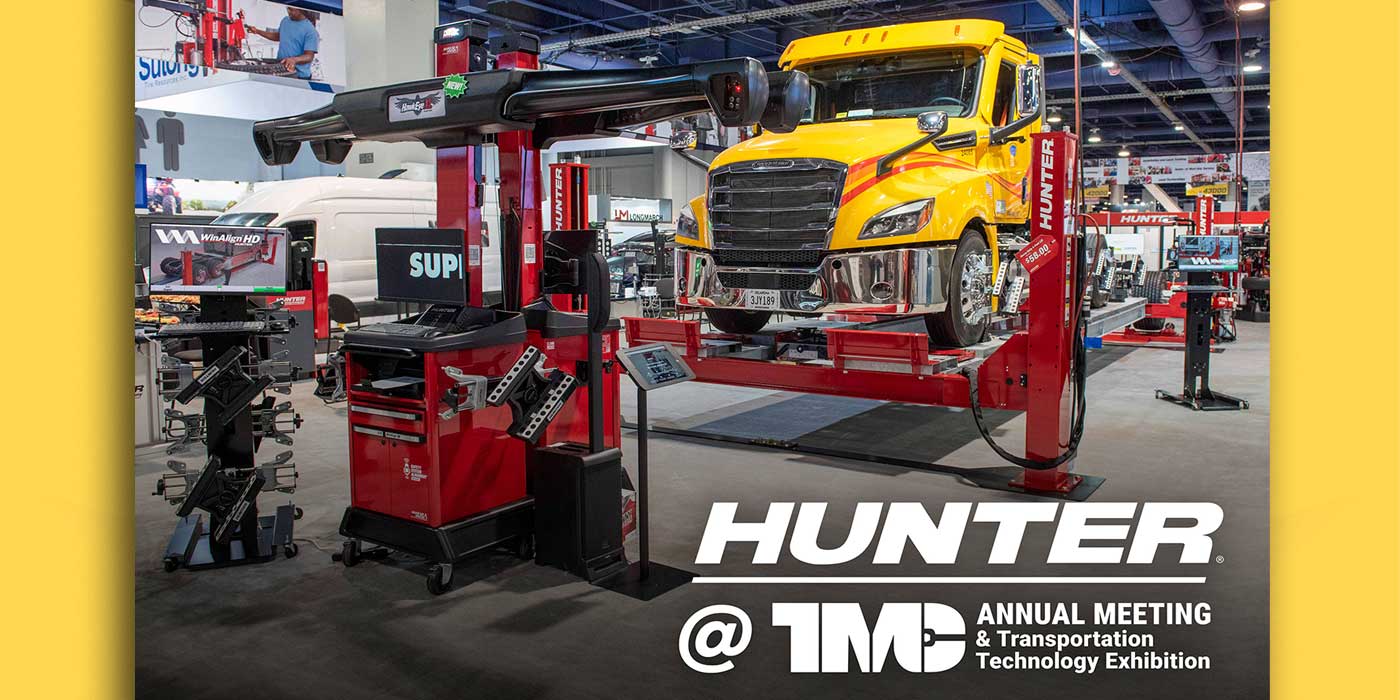A heavy-duty shop can be a dangerous place.
And that’s especially true when there’s a 25,000-plus-lb. vehicle over your head. Heavy-duty lifts are a crucial part of any shop, but considering the risk involved in raising such loads and working under them, it’s clear that it’s incredibly important to make sure that they are maintained and operated correctly. With that in mind, here are seven things to keep in mind when it comes to lift safety in your shop.
1. Pay attention to ALI certification
Each of the lift manufacturers FST spoke with emphasized the importance of certification from the Automotive Lift Institute (ALI).
“The most important thing for lift safety is the ALI standard,” says Peter Bowers, technical sales support manager for
Stertil-Koni. “An ALI-certified lift will ensure the user that they get the safest piece of machinery that’s compliant with all OSHA codes and national electric codes, and includes up to 150% load testing.” (Of course, even though they are tested for a 150% load, you still should not overload the lifts).
So how is ALI certification earned, and why is it important? We asked the organization itself those questions, and here is how R.W. “Bob” O’Gorman, ALI’s president, responded:
“Nearly all building code enforcement agencies across the U.S. and Canada mandate that only certified lifts be installed within their jurisdictions. Obviously, this can help to reduce the potential for workplace injuries, but it is also a critical point when considering that uncertified automotive lifts do not comply with the requirement that electrical products be listed by a third party in order to demonstrate compliance. Since product certification is voluntary in North America, the responsibility for buying and installing certified lifts rests solely with the customer. If a lift does not come with ALI’s gold certification label, you have no way of proving to inspectors—let alone knowing for yourself—that it meets national safety standards.”
(Editor’s note: You can to read more on ALI certification at fleetservicetechnology.com/importance-ali-lift-certification and Automotive Lift Institute website.)
2. Inspect your lifts annually
Speaking of ALI certification, the American National Standards Institute ANSI/ALI ALOIM (current edition) standard states that lifts should be inspected at least annually by a qualified lift inspector.
“ALI recommends all vehicle lifts in service be inspected annually by an ALI Certified Lift Inspector or directly by the lift manufacturer,” notes Dale Soos, senior project engineer for ALI. When performed by an ALI Certified Lift Inspector, a dated lift inspection label bearing ALI’s mark will be applied to each passing lift.
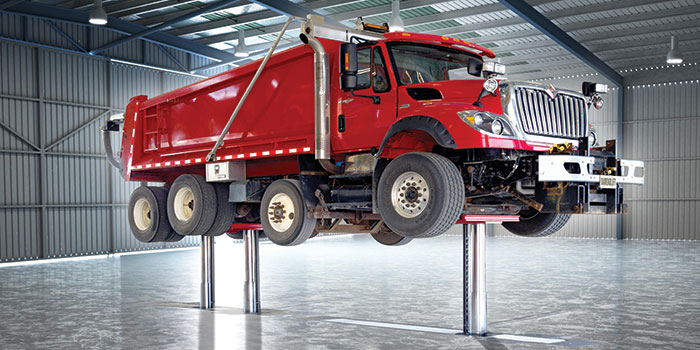
3. Make sure your technicians are trained
Training is incredibly important when it comes to lifts—not just because the technicians will know what to do when operating this potentially dangerous equipment, but because you’ll be creating a culture in your shops in which lift safety, and safety in general, is taken seriously.
“Annual reviews of operation and maintenance manuals or placards by operators/maintainers, along with daily pre-operation lift inspections, creates a culture of safety awareness,” says Doug Spiller, director of heavy-duty product management for the Vehicle Service Group (VSG), which includes Rotary and Chief lifts. “Even something as simple as a visual reminder, such as a light that illuminates when the lift is on its locks, helps operators get in a routine of safe operation.”
This need for training is especially important when considering the high turnover rates and high demand for technicians in the industry right now.
“Lifts are covered by the standards of ANSI, and ANSI says that technicians are supposed to be trained every single year in how to properly use the lift,” says Steve Perlstein, president of Mohawk Lifts. “Sometimes I do safety talks in shops, and I say to the techs: ‘Please raise your hand if you’ve been trained how to use your lift in the last year,’ and I get a bunch of techs in the garage laughing at me.
“But the fact is,” he continues, “this is the ANSI standard. OSHA doesn’t write laws and rules. But OSHA follows the ANSI rules. So if, god forbid, something happened in a shop, then OSHA is going to come in for an investigation, and they’re going to say to the shop manager, ‘Can you please show me the paperwork from the last time you inspected the lift this year? Can you please show me all the training logs where your technicians in your shop have been trained?’
“The last thing I’d want to say is, ‘I knew I was supposed to get my techs trained every year, and my lifts inspected every year, but I didn’t do it.’”
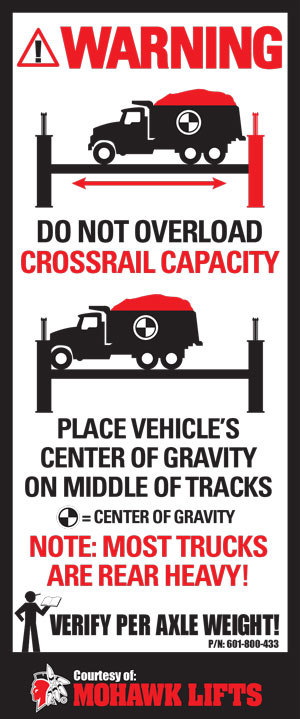 4. Know the weight of the vehicles you are lifting
4. Know the weight of the vehicles you are lifting
This may seem basic, but it’s a crucial first step for a technician operating a lift. If the technician doesn’t know the vehicle’s weight, there are plenty of resources he or she can use to find out, such as the manufacturer’s website.Another safety tip, from Dennis Hanson, senior product specialist for OTC, is that techs should never crawl under a vehicle that is only supported by a floor jack or lift.
5. Center the weight of the vehicle
Not only do you need to know the truck’s weight, but you need to understand how the weight is distributed and lift it accordingly. The physical center of the vehicle is not always the center of the vehicle’s weight.
“Understanding vehicle weight distribution and vehicle stability on lifts is very important,” VSG’s Spiller says. “Removing vehicle components during routine maintenance shifts vehicle weights and can create dangerous situations. Ensure that technicians are using OEM-certified, properly positioned and unmodified accessories. Vehicle type specific adapters, support stands and rolling jacks are all examples of accessories that help the operator stay safe.”
Another lift safety commandment, according to Mohawk’s Perlstein: “Thou shalt not overload the swing arms.”
The reason for this is simple: not every truck is evenly distributed in weight, and each of the swing arms needs to be built to handle the weight they’re bearing. You may use a 20,000-lb.-rated lift for a 20,000-lb. truck, for instance, and assume everything is fine, but if 15,000 of those pounds are in the back end of the truck, you can’t use that lift because you’ll be overloading the back two arms with more weight than they can handle.
Stertil-Koni’s Bowers points out that this is going to be especially key if you start working with electric trucks or buses, because the weight distribution, and thus the correct way to lift the vehicle, is going to be different than the operator is used to.
6. Make sure the lift is on stable ground
“The most important thing when using a floor jack or air lift in a shop is to make sure you are working on level ground when jacking the vehicle and to place a jack stand under the vehicle once it is elevated,” OTC’s Hanson says. “The floor jack or lift and the jack stand should always be rated at a higher weight than the vehicle.”
“Stability is key,” agrees Stertil-Koni’s Bowers, who notes that with mobile column lifts, you have to ensure that you are on firm ground for lifting, and you have to make sure that the foundation doesn’t have too much slope, because if it does, the mobile columns can become unstable.
Bowers also recommends that when a technician is raising a lift, he or she should only raise the vehicle 12 in., stop, and do a full 360-degree walk around the vehicle to make sure everything is stable, that the load looks well distributed and that it looks like it’s on level ground, before they proceed.
7. Use the appropriate accessories
You’ll also want to make sure that only approved accessories are being used with your lifts, such as high reach jack stands. According to ALI’s Soos, the use of non-certified options or accessories on a certified lift will void that lift’s certification for as long as the original configuration remains altered. So you’ll want to check the certification of your accessories as well, or even an ALI-certified lift will be considered noncompliant—and more importantly, would be considered unsafe for the application.

Also, Paul Feldman, director of marketing for Stertil-Koni, notes that “you want to make sure that only authorized people are operating the lift; you can do that by selecting a lifting system that locks out unauthorized access.”
Again, it’s important to remember the reason for all these rules and regulations. These aren’t just arbitrary rules set for the sake of having rules; safety is of vital importance when using any shop equipment considering the risks involved, so proper procudures need to be followed.
“The last thing you want is an injured employee,” says Stertil-Koni’s Bowers. “So all of these things—having the operators properly trained, and retrained if they need to be, and inspecting and certifying the lifts—will ensure that you generate a culture of safety, so the operator isn’t overlooking any potential safety concerns in an effort to get his or her work done faster.”

